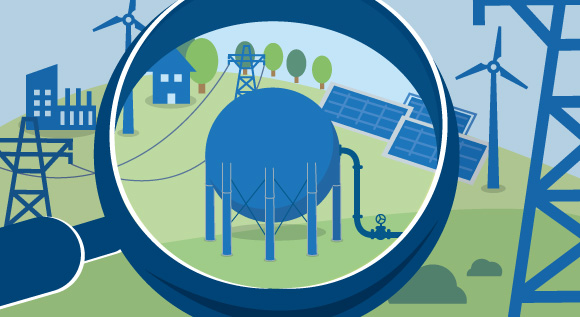What exactly is carbon leakage?
Emissions trading, carbon pricing and carbon leakage are familiar terms in the context of climate action and the EU economy. But what exactly is carbon leakage and why is it so important right now? Read on to find out.
 © BMWi
© BMWiThis is what it’s all about: ringfencing Europe’s climate action.
Mitigating climate change and global warming is a global task to which Europe wants to make an important contribution. By virtue of its Green Deal, Europe is seeking to become the first climate-neutral continent by 2050. For this purpose, many European countries have committed to stricter climate regulation, e.g. for their energy-intensive industries. But what if others fail to do as much?
Whilst the Paris climate agreement represents an important step towards the global coordination of efforts to mitigate climate change, it does not create a level global playing field for industry.
The European emissions trading system: carbon emissions come at a price
Europe is leading the way: The European emissions trading system (ETS) requires the energy industry, energy-intensive industries and aviation services operating within the EU to pay a price for the emissions they cause. The ETS covers almost half of all European greenhouse gas emissions, making it a key instrument for decarbonising our economy.
For each tonne of harmful greenhouse gas they emit, companies subject to the ETS must purchase ETS certificates, which they can trade with one another. This is to create economic incentives for reducing emissions and to help Europe achieve its climate targets. A company that reduces its greenhouse gas emissions will have to spend less on emission certificates. In other words, ETS is a market-based instrument that is part of our market economy.
Depending on how much effort companies have already made to curb their emissions, ETS certificates can be quite a cost factor for them. As a consequence, companies that are not subject to European emissions trading and hence do not have to purchase certificates may have a competitive advantage. When European companies decide to relocate their production and therefore also their emissions to countries that have less strict climate regimes, this is called carbon leakage. Carbon leakage is bad for the economy and for jobs in the EU. And it is bad for the climate. For this reason, the EU is trying to prevent carbon leakage. The measures taken for this purpose need to be adjusted to the higher climate ambitions enshrined in the Green Deal.
This is how the EU wants to prevent carbon leakage
Companies working in sectors that are threatened by carbon leakage receive a higher share of free ETS certificates than companies from other sectors. Prior to this, a precise impact assessment is made for each industry. The relevant industries are then designated on an official list that needs to be approved by the Member States and the European Parliament. Further to this, electricity-intensive companies in Germany receive electricity price compensation to compensate for the increased electricity costs caused by emissions trading (indirect carbon costs).
But what size of competitive disadvantage are we talking about for these companies? Let’s take an example from the steel industry: the production of one tonne of steel generates some 1.7 tonnes of carbon dioxide. Multiplied by a carbon price of €50 per tonne of CO2 emitted, this results in an extra cost of €85 per tonne of steel. Assuming a steel price of €400 per tonne, this corresponds to a surcharge of more than 20%. This then raises production costs for industrial goods in the EU.
And climate action can only be successful if it is organised in a way that allows for economic prosperity, too. This is the only way to persuade emerging economies and developing countries that climate action is worth it, and it is the only way to ensure universal acceptance for climate action.

